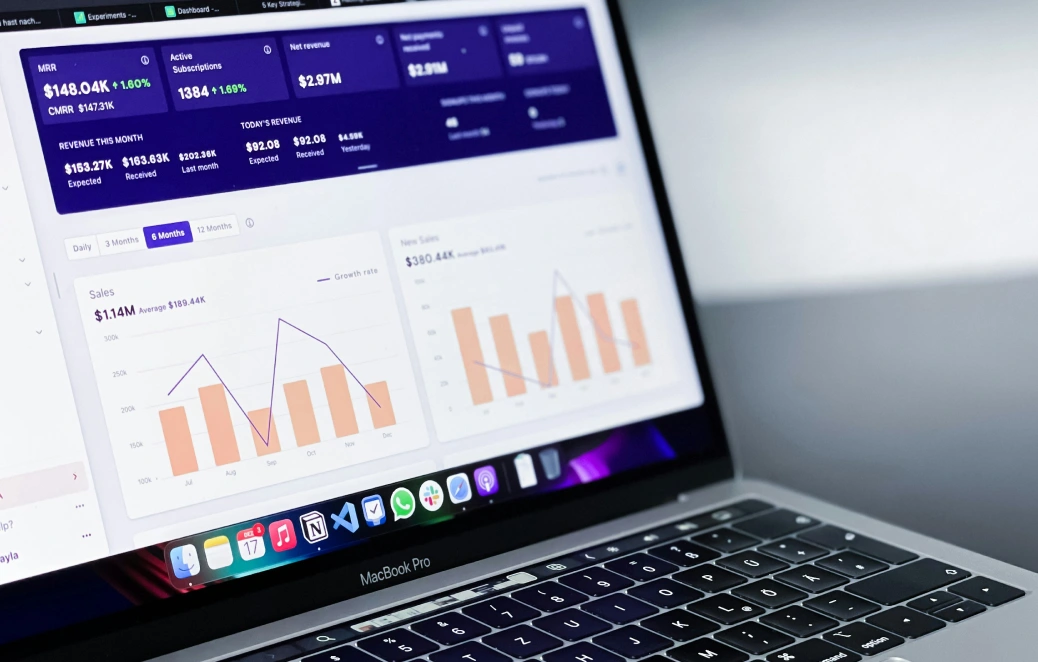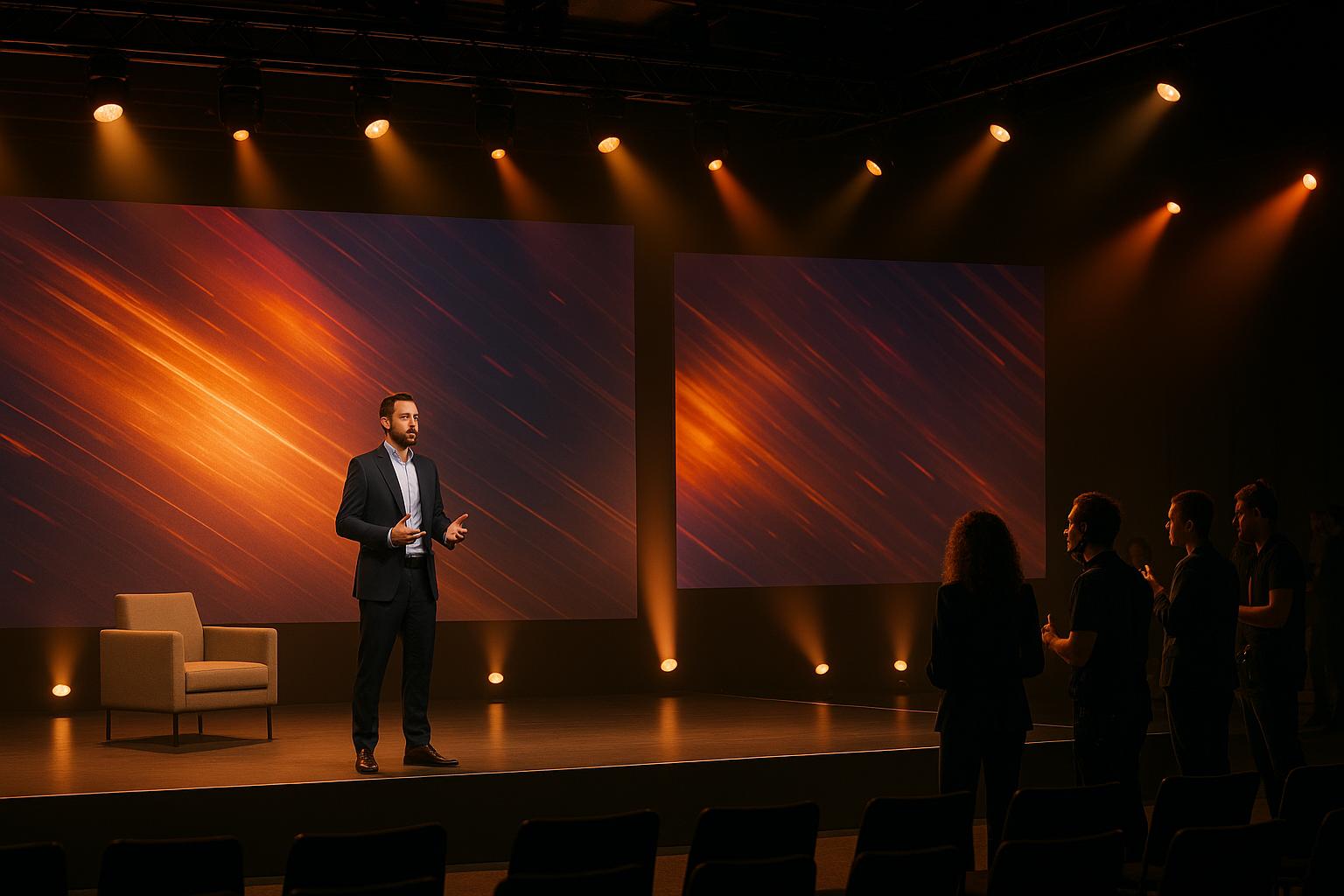10 Leading AI solutions for Conference Production

Chief Executive Officer
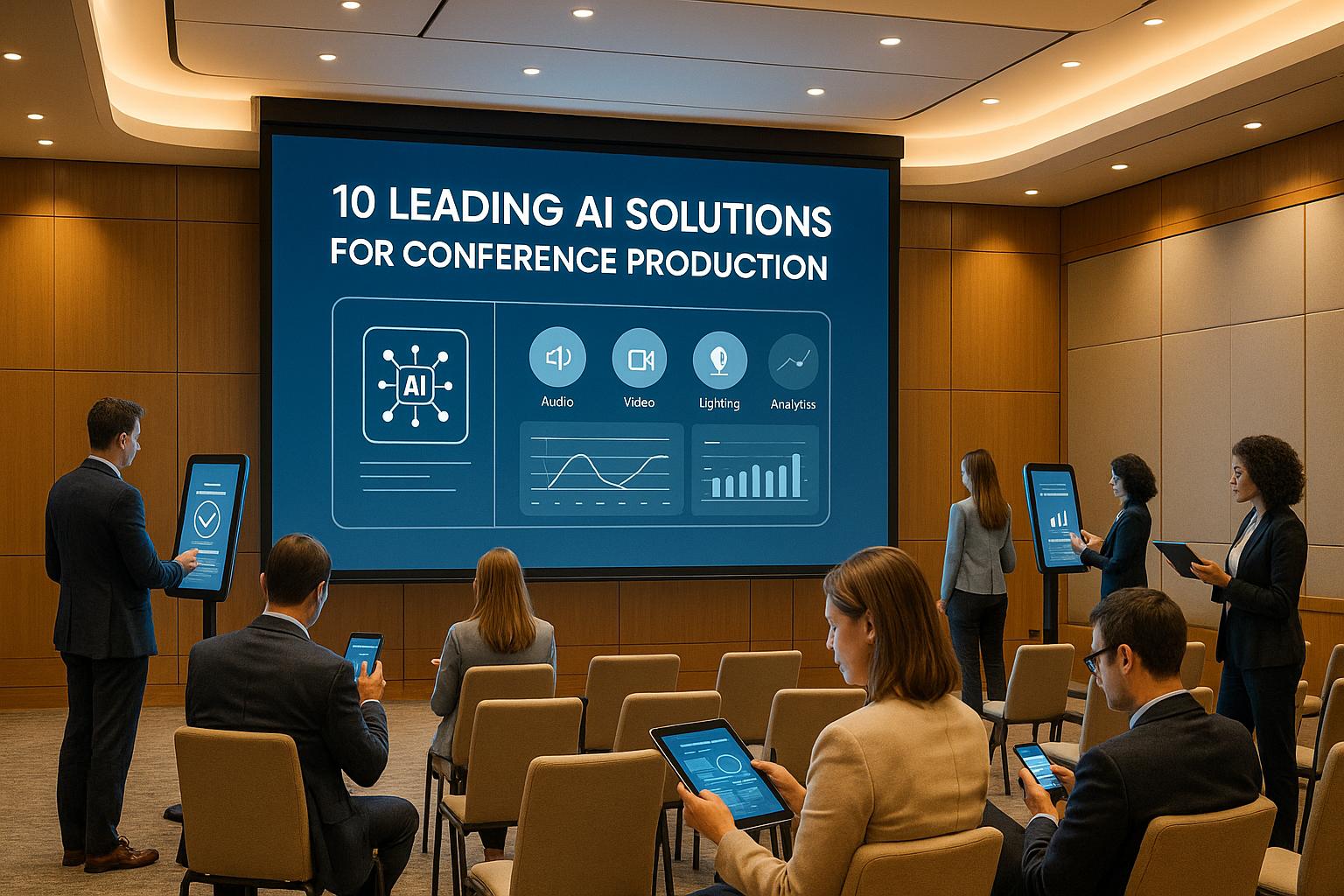
Effortlessly planning and managing conferences is now possible thanks to AI tools. From event setup to post-event analysis, these solutions save time, cut costs, and improve attendee experiences. Here’s a quick breakdown of the top 10 AI-powered platforms transforming conference production:
- Corporate Optics: Enhances virtual meetings with interactive features like live polls and custom-branded environments.
- Cvent: Simplifies venue selection, scheduling, and attendee engagement with predictive analytics and tailored agendas.
- Hopin: Offers real-time language support, personalized networking, and automated attendee analytics for virtual and hybrid events.
- Eventbrite: Streamlines event planning, marketing, and post-event analysis with AI-driven tools.
- Zoom: Delivers live transcription, noise suppression, and post-event transcripts for virtual conferences.
- Otter.ai: Provides accurate real-time transcription, session summaries, and seamless integrations with collaboration tools.
- Whova: Combines event planning, live audience interaction, and detailed post-event analytics in one platform.
- Bizzabo: Focuses on automating event marketing, personalizing attendee experiences, and delivering actionable insights.
- Pathable: Specializes in AI-powered networking to help attendees connect effectively.
- Prysm AI: Offers live streaming and broadcasting solutions tailored to conference needs.
These tools address key challenges like logistics, audience engagement, and data analysis, making conferences more efficient and impactful. Whether you're hosting a small meeting or a large-scale event, these platforms can simplify the process while enhancing the overall experience.
5 AI tools you need for your events
1. Corporate Optics
Corporate Optics, an Emmy Award-winning company founded by Steven P. Simmons, is a leader in technical event production and audiovisual solutions. The company collaborates with prompts.ai to simplify and enhance corporate meetings and events.
Audience Engagement
When it comes to virtual meetings, Corporate Optics focuses on creating engaging and interactive experiences. This includes the use of features like dynamic presentation displays, live polls, Q&A sessions, and custom-branded virtual environments to keep participants involved and connected.
2. Cvent Event Management AI
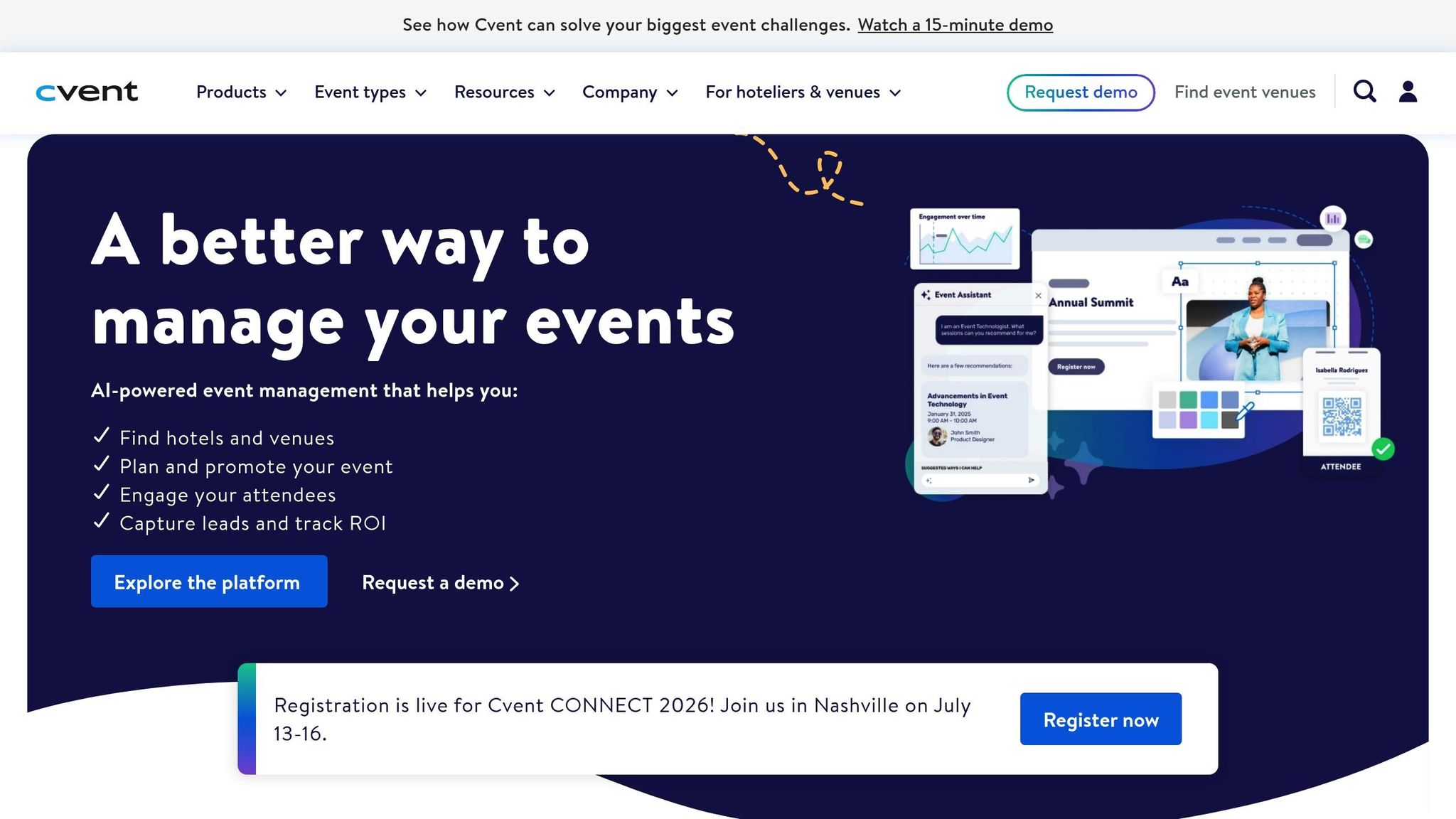
Cvent's AI-driven event management platform supports conference organizers every step of the way, from initial planning to post-event analysis.
Streamlining Event Planning and Management
Cvent’s venue matching tool takes the guesswork out of finding the perfect location. By analyzing event requirements, attendee demographics, and budgets, it recommends venues that align with your needs. Plus, its predictive analytics help forecast attendance by examining trends and registration data, reducing the risk of overbooking or underbooking.
Scheduling becomes a breeze with smart algorithms that identify conflicts - like speaker availability, room capacity, or equipment needs - and adjust schedules in real time. On top of that, the platform enhances the attendee experience with tools designed for personalized engagement.
Enhancing Audience Engagement
Cvent uses AI to analyze attendee behavior, session preferences, and networking goals, creating tailored agendas for each participant. Its networking features go a step further by suggesting connections based on professional backgrounds and shared interests, making it easier for attendees to build meaningful relationships.
The platform also incorporates real-time sentiment analysis, tracking feedback from surveys and social media to gauge session quality and speaker performance. These insights allow organizers to make quick adjustments during the event, ensuring a better experience for everyone involved. This focus on engagement naturally sets the stage for deeper insights after the event.
Turning Data into Actionable Insights
Once the event wraps up, Cvent transforms the collected data into clear, actionable insights through its analytics dashboards. These detailed reports cover everything from attendance and engagement metrics to revenue figures, helping organizers demonstrate the event's success and plan for future improvements.
The platform also uses predictive modeling and automated surveys to identify attendee trends and pinpoint areas for growth, ensuring each event builds on the success of the last.
3. Hopin AI-Powered Event Platform

Hopin transforms the way virtual and hybrid conferences are managed by integrating AI into every step of the process. It simplifies event planning, boosts attendee engagement, and provides actionable insights after the event wraps up.
Here’s what makes Hopin stand out:
- Effortless scheduling and session management: Organize events with ease, keeping everything on track.
- Tailored audience interaction and networking: Create personalized experiences that connect attendees meaningfully.
- Real-time language support: Break down language barriers and make events accessible to global audiences.
- Automated attendee analytics: Gain valuable insights from participant data without the manual effort.
Hopin leverages AI to make hosting conferences smoother and more impactful for organizers and attendees alike.
4. Eventbrite AI Tools for Conferences
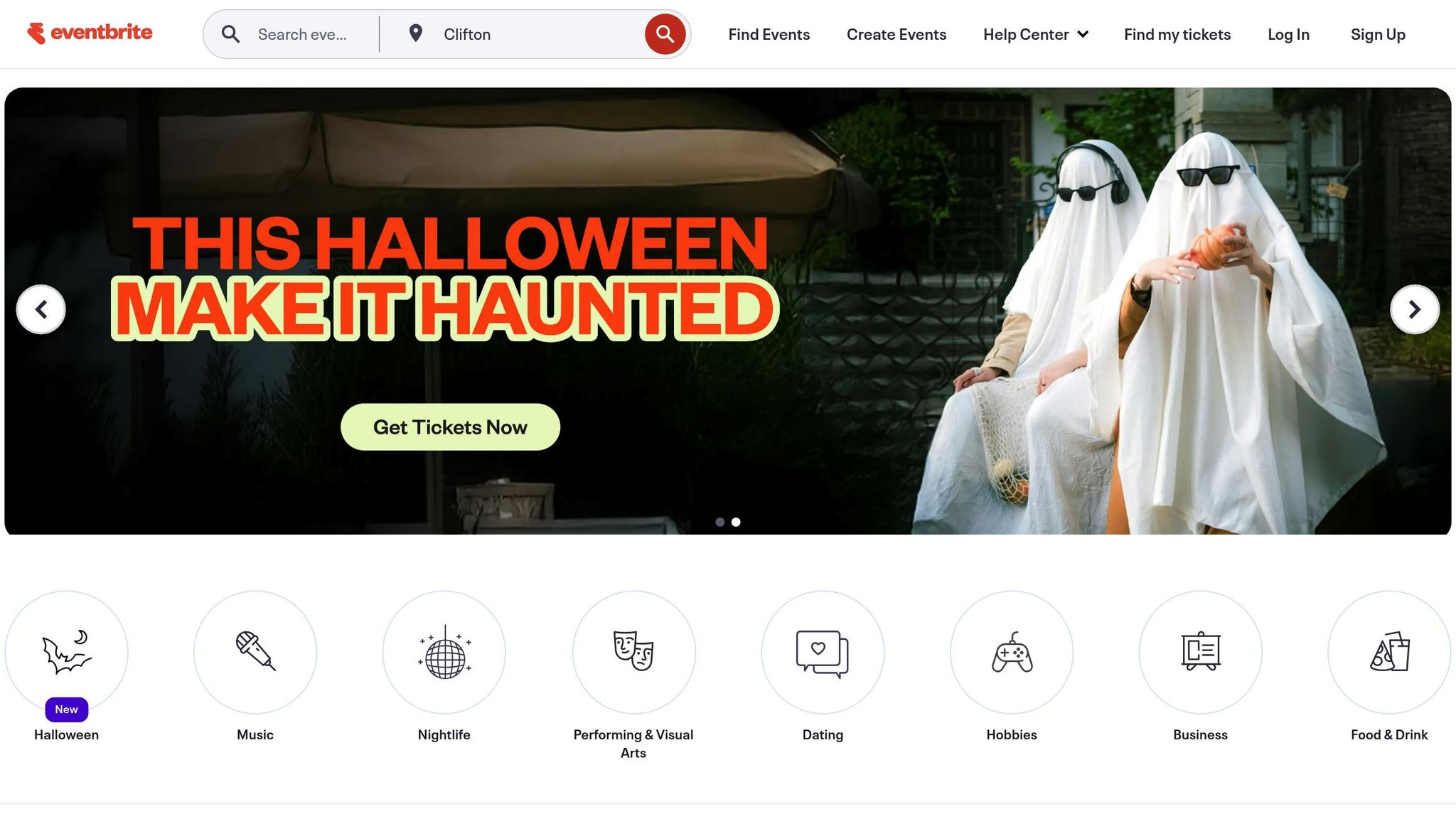
Eventbrite takes AI beyond simple planning tools, integrating it into the entire event lifecycle to make managing conferences more efficient. Their AI-powered features simplify tasks like planning, marketing, and analyzing events after they’ve wrapped up. While some details about these tools remain under wraps, they clearly aim to improve how organizers handle every aspect of their events, ensuring a smoother and more effective conference experience.
5. Zoom AI for Virtual Conferences
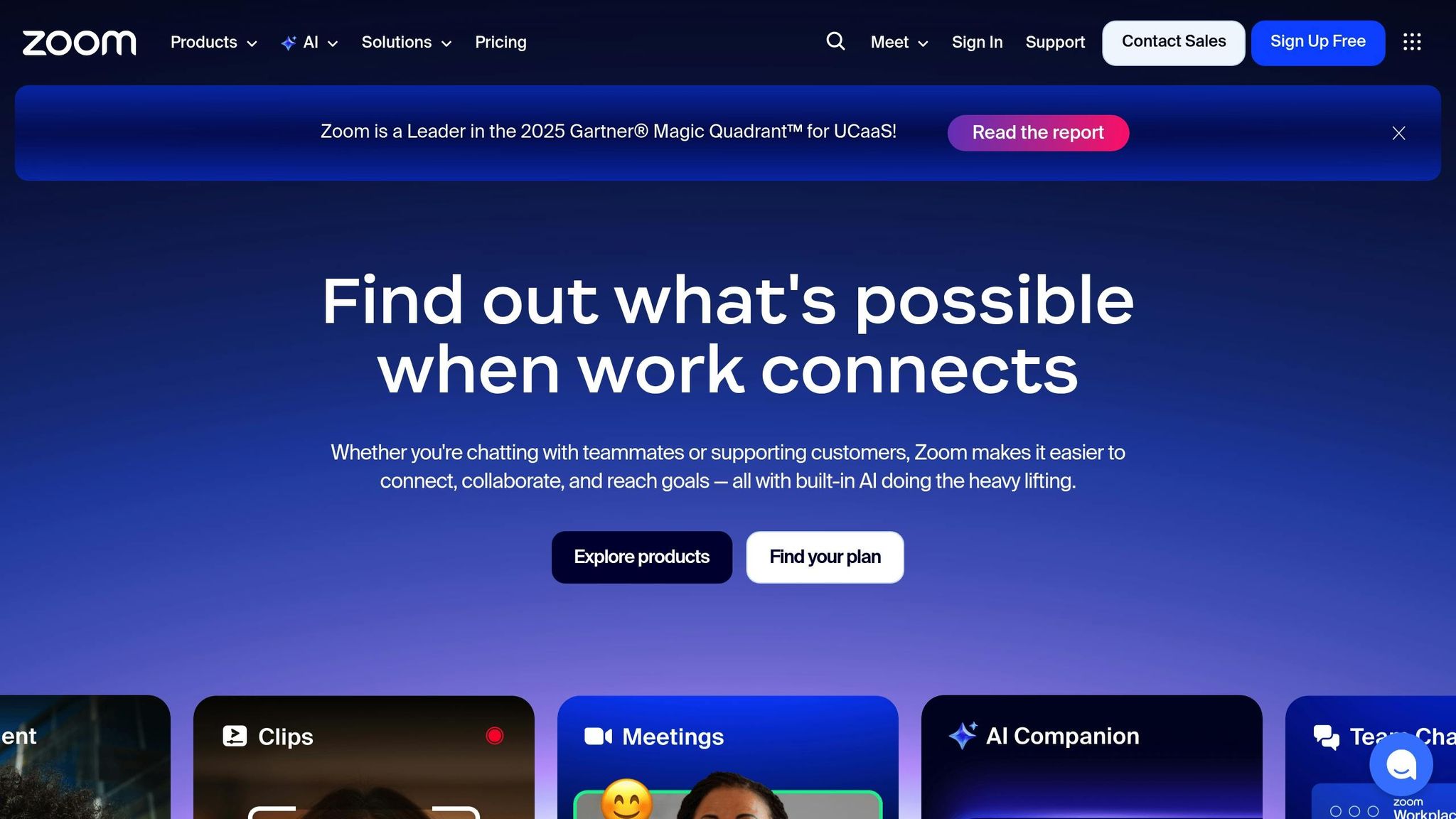
Zoom stands out in the world of virtual conferences by incorporating AI tools that improve accessibility and streamline post-event tasks.
One standout feature is Live Transcription, which uses automatic speech recognition to deliver real-time captions during sessions. It also generates transcripts automatically, making it easier to review discussions after the event. This is particularly helpful for ensuring everyone stays on the same page, whether they attended live or are catching up later.
Another key feature is advanced noise suppression, which ensures crystal-clear audio quality, even in less-than-ideal environments with background noise.
These tools work together to make virtual conferences smoother and more inclusive, showing how Zoom uses AI to tackle real-world challenges in professional communication.
sbb-itb-ae35a94
6. Otter.ai for Real-Time Transcription
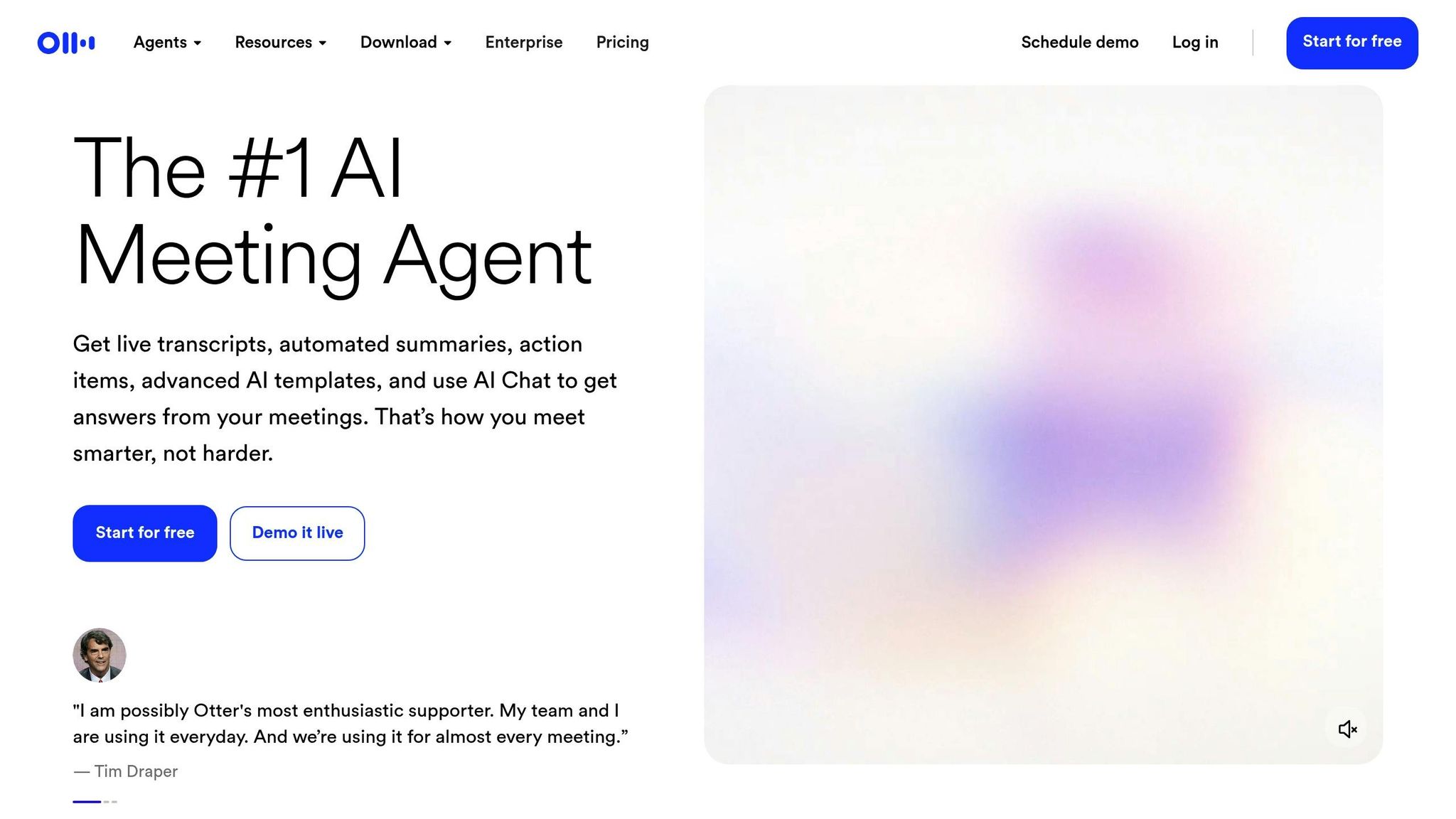
Otter.ai brings a game-changing approach to conference production with its AI-powered live transcription, making events more accessible and efficient. With accuracy rates of up to 95%, it ensures attendees can follow along with the content as it’s spoken, in real time.
Real-Time Transcription Capabilities
At the heart of Otter.ai is its ability to deliver live transcription during sessions. This feature is invaluable for attendees who are hearing-impaired, non-native speakers, or those who simply prefer reading along for better understanding. The platform seamlessly integrates with popular tools like Zoom, Google Meet, and Microsoft Teams, embedding live transcription directly into the conference setup.
"It's an incredible app. The most accurate app out there [for transcription]." - Tony Robbins
Otter.ai also includes an AI Chat feature, allowing participants to interact with session content in real time. Attendees can ask questions about specific topics covered or even generate follow-up emails based on the session’s discussions.
Streamlining Event Planning and Management
Otter.ai simplifies event management by automating session summaries, cutting down hours of manual work. In fact, it can save event producers over four hours every week. Its AI Meeting Agent can also be scheduled via Google Calendar to join meetings automatically, ensuring consistent transcription coverage without any extra effort.
Post-Event Analytics and Reporting
After the event, Otter.ai integrates with platforms like Dropbox, Google Docs, HubSpot, Salesforce, Slack, and Asana, making it easy to share transcripts and action items. Teams can collaboratively edit transcripts to refine them before sending them out to stakeholders. Key decisions and action items are automatically captured and can be sent directly to project management tools like Jira and Asana, streamlining follow-ups.
"Otter is a must-have. Just being conservative - our team is getting 33% time back." - Laura Brown, Vice President of Sales at Aiden Technologies
Otter.ai offers flexible pricing options. The free Basic Plan includes unlimited meetings and core integrations, while the Business Plan, priced at $19.99 per month per user, provides additional features like 6,000 monthly transcription minutes and collaborative editing.
With its combination of real-time transcription and seamless post-event integrations, Otter.ai is setting new standards for AI-driven conference solutions.
7. Whova AI Event Management Software
Whova brings together event planning, attendee engagement, and analytics in one comprehensive platform. It’s designed to help organizers handle events with greater ease and efficiency. Let’s break down how Whova simplifies the planning process, boosts attendee interaction, and provides valuable insights for future events.
Event Planning and Management
Whova takes the hassle out of registration and session coordination, allowing organizers to focus on delivering a smooth and enjoyable event experience. By managing the logistical details, the platform frees up time for organizers to concentrate on execution and strategy.
Audience Engagement
Keeping attendees engaged is key to a successful event, and Whova makes it easier with features like live polls and Q&A sessions. These tools not only encourage interaction but also help organizers collect real-time feedback, creating opportunities for meaningful connections during conferences.
Post-Event Analytics and Reporting
Once the event wraps up, Whova’s analytics tools step in to provide detailed insights on attendee participation and overall performance. By analyzing engagement metrics and feedback, organizers can pinpoint what worked well and use those insights to improve future events. It’s a smart way to refine strategies and deliver even better experiences.
8. Bizzabo AI for Event Marketing and Analytics
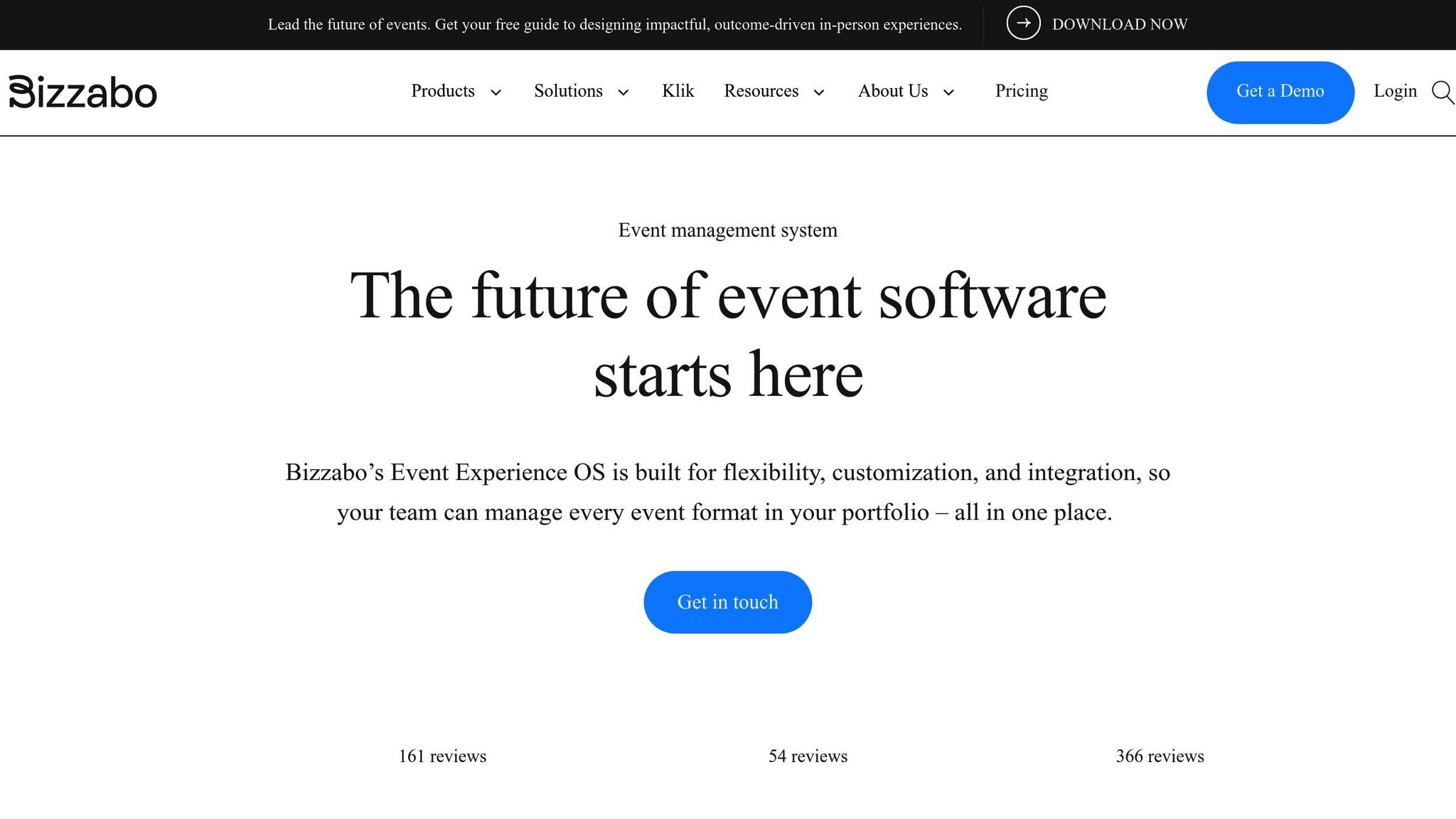
Bizzabo is an AI-powered platform designed to simplify event marketing, planning, audience engagement, and post-event analysis. Let’s break down how it supports each stage of the event process:
Event Planning
Bizzabo takes the hassle out of event planning by automating repetitive marketing tasks and managing resources efficiently. This allows organizers to devote more time to crafting events that captivate their audiences.
Personalized Audience Engagement
Once the planning is in place, Bizzabo shifts its focus to the attendees. By tailoring communication, content, and session recommendations to each participant, it ensures a more personalized experience. Attendees can easily discover sessions and networking opportunities that align with their specific interests, making their event experience both meaningful and enjoyable.
Data-Driven Post-Event Analysis
After the event wraps up, Bizzabo provides detailed analytics to evaluate its success. These insights not only highlight the event's impact but also offer valuable guidance for improving future events.
9. Pathable AI-Powered Event Networking
Pathable takes attendee engagement to the next level by focusing exclusively on event networking. Unlike platforms that cover a broad range of event management tasks, Pathable hones in on connecting participants, using AI to make those connections more meaningful and effective.
While specific details about its AI networking features aren’t widely available, you can reach out to Pathable directly to learn more about how their technology facilitates better networking experiences.
This tool adds another layer to the growing list of AI solutions transforming every aspect of conference production.
10. Prysm AI for Live Streaming and Broadcasting
Prysm AI specializes in live streaming and broadcasting solutions tailored for conference production. While specific details about its features and functionality are not widely available, you can reach out directly to Prysm AI to learn more about what they offer.
Conclusion
AI has revolutionized conference production, streamlining everything from initial planning to post-event analysis. The ten tools discussed here form a powerful ecosystem, helping event producers design engaging experiences while reducing operational headaches.
These AI-driven solutions enable organizers to personalize attendee experiences on a large scale without piling on hours of manual work. Live streaming platforms now deliver high-quality broadcasts, and advanced analytics turn raw data into actionable strategies for future events.
A striking example of AI's impact comes from Microsoft Azure's tools, which were used at CES to analyze live sentiment and enhance sponsor engagement. The result? A 28% improvement in outcomes. This showcases how AI can influence every aspect of event production in meaningful ways.
As these tools advance toward more autonomous capabilities, they will continue to simplify processes and amplify human creativity. These systems are designed to make decisions, execute complex actions, and adapt in real time to meet event objectives.
"AI is a co-pilot, not a replacement... it still needs you at the wheel."
– XR & AI in Events Report, Events.com
For event producers looking to integrate AI, the best approach is to start small. Identify one specific challenge - whether it’s crafting speaker introductions, generating session titles, or creating social media posts - and let AI provide a first draft that you can refine. This "generate, then curate" workflow combines efficiency with the human touch.
The future of conference production lies in the partnership between AI and human ingenuity. By automating repetitive tasks and delivering data-driven insights, AI allows producers to focus on what truly matters: creating events that leave a lasting impression and drive success.
The tools are here, and the benefits are undeniable. The real question is - how soon will event organizers embrace these capabilities to elevate their next event?
FAQs
How do AI tools enhance attendee engagement in virtual and hybrid conferences?
AI tools are transforming how attendees experience virtual and hybrid conferences by making interactions more engaging and personalized. Take AI-powered matchmaking, for instance - it connects people with similar interests or aligned professional goals, creating opportunities for more meaningful networking.
On top of that, AI delivers customized content, such as session recommendations, event highlights, or summaries, tailored to individual preferences. Features like real-time sentiment analysis and dynamic polling let organizers measure audience reactions in the moment and adjust accordingly, keeping sessions interactive and engaging. These advancements help attendees stay connected and actively participate throughout the event.
What are the main advantages of using AI for post-event analysis in conference production?
AI brings a range of benefits to post-event analysis in conference planning. One standout feature is its ability to analyze feedback automatically. By sifting through survey responses, AI identifies actionable takeaways for future events, saving time while ensuring no important input is missed.
It also highlights attendee behavior patterns, such as engagement levels, session participation, and how attendees interacted with content. These insights help planners understand what truly resonated with their audience. On top of that, AI works quickly and without bias, often delivering a clear analysis within minutes of an event's conclusion. This allows organizers to pinpoint successes and areas for improvement without the risk of subjective interpretation.
By using AI, conference producers can make smarter, data-driven decisions to streamline operations, elevate attendee experiences, and set the stage for even better events in the future.
How can AI help simplify the logistics and planning of a conference?
AI has the potential to take the hassle out of conference logistics by automating tasks that typically eat up a lot of time. For example, it can handle assigning reviewers, grouping presentations into sessions, and even crafting session titles and summaries. These features not only save organizers hours of work but also bring a level of precision and smoothness to the planning process.
With AI-powered tools, event organizers can fine-tune schedules, manage resources more effectively, and dedicate their energy to enhancing the attendee experience. The outcome? A more efficient planning process and a polished, well-executed event.
Related Blog Posts
